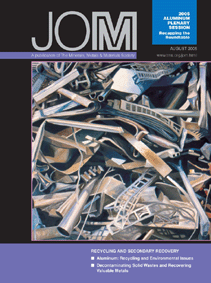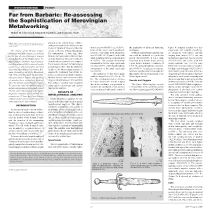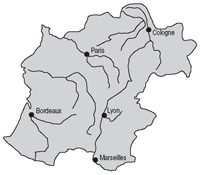 LATEST ISSUE |
||||
TMS QUICK LINKS: |
• TECHNICAL QUESTIONS • NEWS ROOM • ABOUT TMS • SITE MAP • CONTACT US |
JOM QUICK LINKS: |
• COVER GALLERY • CLASSIFIED ADS • SUBJECT INDEXES • AUTHORS KIT • ADVERTISE |
|
| Archaeotechnology: Feature | Vol. 57, No.8, pp. 51-55 |
Far from Barbaric: Re-assessing the
Sophistication of Merovingian Metalworking
ROBERT M. EHRENREICH, ELIZABETH HAMILTON, AND SAMUEL K. NASH
| ||||
| ||||
| ||||
| ||||
| ||||
| ||||
| ||||
| ||||
| ||||
| ||||
| ||||
|
Questions? Contact jom@tms.org. © 2005 The Minerals, Metals & Materials Society |
The demise of the Roman Empire during the mid-fifth century A.D. resulted in the rise of one of Europe’s longest ruling families of the Middle Ages: the Merovingians. The Merovingian dynasty lasted from the mid-fifth to the mid-eighth centuries A.D. and at its height controlled states that stretched across France, Belgium, Germany west of the Rhineland, and most of Switzerland. Archaeometallurgists used to believe that the state of metalworking technology declined after the demise of the Roman Empire. To assess the level of sophistication of metalworking during this period, a set of 36 iron tools and weapons were metallurgically sampled and examined. For comparison, 11 Iron Age, three Roman, and four medieval iron artifacts from the same region were also sampled. INTRODUCTION Archaeometallurgists used to believe that the state of metalworking technology, including blacksmithing, declined after the demise of the Roman Empire and the invasion of the marauding “barbarian” tribes. As Smith and Forbes stated: “The fall of the Roman Empire was heralded by a gradual decline of central authority and consequently by a decline of metallurgy and mining.”1 To assess the level of sophistication of metalworking during this period, a set of 36 iron tools and weapons were metallurgically sampled and examined from the second largest collection of Merovingian artifacts in the United States, which is in the possession of the William R. and Clarice V. Spurlock Museum of the University of Illinois, Urbana-Champaign. For comparison, 11 Iron Age, three Roman, and four medieval iron artifacts from the Spurlock Museum’s collection from the same region were also sampled. The museum obtained the Merovingian assemblage in 1924. (See the sidebar for details on the Merovingian dynasty.) It supposedly originated from Butte des Gargans, which was a burial mound near Houdan, France, and was recovered by Auguste Moutié between 1832 and 1838. The artifacts sampled were examined using optical microscopy and electron microprobe analysis.
Of the 60 artifacts sampled, 52 contained sufficient sound metal to permit metallurgical analysis. The objects examined consisted of seven swords, 14 spearheads, 11 axes, seven daggers, three arrowheads, five nails, three buckles, one shield boss, one pair of tweezers, and one link of chain mail. Following standard metallographic procedure, small portions of the edges of each artifact were removed and mounted in thermosetting resin. The samples were then polished and etched with a 2% nital solution. The results of the metallurgical analyses are presented by artifact type.
Spearheads The only distinguishable difference between the two Merovingian spearhead types is in the phosphorus contents. Microbe analysis revealed that the three large spearheads were predominantly made from low-phosphorus iron, with only one having a phosphorus concentration in excess of 0.080% (i.e., 0.085%). Four of the seven small spearheads, however, were made from phosphoric iron (1924.02.301; Figure 3), with a fifth small spearhead having a concentration of 0.078%. The average phosphorus concentration for the large spearheads was thus 0.055%, while the phosphorus concentration of the small spearheads was 0.140%. The hardnesses for the Merovingian artifacts ranged from 93.5 Hv to 248 Hv. The consistent relative softness of these spearheads would suggest that either resilience was preferred to hardness for spearheads or the artifacts were not deemed sufficiently worthy of the application of advanced hardening techniques. Of the other spearheads sampled, only one could be attributed to a particular period (1924.02.0030). It was a small spearhead from Roman times and had a pure ferritic structure, a hardness of 120.8 Hv, and a phosphorus concentration of 0.097%. Its type, grain structure, hardness, and phosphorus concentration thus parallels the small spearheads of the Merovingian period.
Swords and Daggers The wide variation in the application of advanced hardening processes for the Merovingian swords indicates an acceptance of variable performance characteristics for these weapons. The overall lower phosphorus contents, however, might suggest that Merovingian blacksmiths were deliberately selecting this type of material for the production of prestige weapons. The four other swords sampled were of Iron Age date and revealed similar heterogeneity and complexity (1922.07.0026, 1924.02.0309, 0310, and 0311). The one sword with a low carbon content (i.e., 0.2%) was ferrite with varying amounts of pearlite (1922.07.0026). Two of the three swords (1924.02.0310 and 0311) with higher carbon contents (i.e., 0.5%) displayed a banded, ferrite/pearlite structure indicative of piling and air cooling after having been raised to temperatures in excess of 900ºC. These two artifacts had an average hardness of 257.8 Hv. One of these swords also possessed a high phosphorus content (1924.02.0311). The remaining high-carbon sword (1924.02.0309) was a clearly superior weapon, with a martensitic grain structure indicative of quenching and a hardness of 711 Hv (Figure 5). It showed no evidence of piling.
Axes Of the other axes sampled, only two could be attributed to a particular period. The two Iron Age “battle” axes sampled displayed similar diversity to the Merovingian artifacts. One (1924.02.0025) revealed a carbon concentration of 0.2% and a hardness of 166.4 Hv. The other (1924.02.0028) displayed a high carbon content, a bainitic grain structure indicative of quench hardening (Figure 8), and a hardness of 340.7 Hv. Both axes were made from non-phosphoric material. Other Merovingian Artifacts
Other Non-Merovingian Artifacts The one other Roman artifact sampled was a shield boss (1924.02.008). The artifact had a phosphorus concentration of 0.118%, a carbon concentration of 0.2%, and a hardness of 179.8%. The additional medieval artifacts sampled consisted of one link from a piece of chain mail and three blades. The link of chain mail (1924.02.0295) revealed a purely ferritic structure with evidence of excessive cold-working (Figure 9). Its hardness measured 196 Hv, and it could have been made from drawn iron wire. Its phosphorus concentration was 0.130%, which is interesting because phosphoric iron was preferentially used for drawing harpsichord wire during the 17th and 18th centuries, since the higher phosphorus content would increase hardness while easing production.3 This link of chain mail might therefore suggest that the preferential use of phosphoric material for drawing wire predated the 17th century. The three medieval blades again showed a range of structures and properties. Two (1917.05.0019 and 0021) were almost pure ferrite—one of which revealed considerable cold-working— and both had hardnesses in the 100–200 Hv range. The remaining blade (1917.05.0020) possessed a carbon concentration of 0.7%; a martensitic grain structure, again indicative of quenching; and a hardness of 597.5 Hv. No evidence of piling was visible in any of the artifacts. The two pure ferrite blades were made from phosphoric material. CONCLUSIONS The Merovingian artifacts display a remarkable variation in hardness, metallurgical treatment, and, hence, resulting performance. In almost every class of tool and weapon, some of the artifacts showed the use of advanced heat treatments while others were left as pure ferrite. The knowledge of how to carburize and quench bloomery iron was thus clearly available but was by no means always—or even frequently—applied. The use of carburization and quenching does not appear to be any more consistent during the Iron Age, Roman, and medieval periods, however, based on the other artifacts sampled. The same variation in the application of advanced metallurgical techniques can be seen in these artifacts as well. Although scholars have tended to assume that Roman smiths should have displayed an industrial level of consistency in accord with their industrial level of production, studies of Roman-period edged tools in the British Isles have shown that the production of steel was by no means any more consistent than during the Iron Age.4 This fact has led many archaeologists to wonder whether the use of advanced techniques was limited by social (e.g., the technique was kept proprietary by master smiths), tactical (e.g., preference for a moderately hard and consistent steel to a brittler and perhaps unpredictable quenched steel), or economic (e.g., quenched artifacts were of higher value and therefore rarer, especially in gravegoods) reasons.
The only consistency discovered among the Merovingian artifacts sampled was that the more commonplace and less technologically sophisticated artifacts (i.e., nails, buckles, hoe, tweezers, arrowheads, and smaller spearheads) were generally made from phosphoric iron, while the more technically sophisticated and valuable items (i.e., swords, daggers, axes, and large spearheads) were generally made from low phosphorus material. The average phosphorus contents were 0.071% for the more intricate artifacts and 0.186% for the less complex artifacts. The data suggest that Merovingian blacksmiths were preferentially selecting phosphoric iron for those artifacts that were less likely to be carburized and quenched, which would be a metallurgically sound practice. Phosphorus concentrations in excess of 0.080% restrict the diffusion of carbon in iron and thus make it more difficult to produce an even carbon distribution. Smiths therefore should have avoided it for those artifacts that they planned to heat treat. High phosphorus concentrations, however, can also have beneficial effects on the properties of ferritic metal. Although grain boundary segregation of phosphorus may reduce grain boundary cohesion and thus make the material cold short, intragranular concentrations of phosphorus help pin dislocation movement in iron and therefore make the metal naturally harder.5 Phosphoric iron actually appears to have been deliberately selected during the late Iron Age for its natural hardness, when knowledge of advanced heat treatments was less widely available.6 With the spread of advanced heat treatments, however, blacksmiths may have come to realize the unsuitability of high-phosphorus material for technically sophisticated tools and weapons and limited its use to those objects that were not to be subjected to heat treatment. So what does this preliminary study show of the differences between the Merovingian iron industry and those of the Iron Age, Roman, and medieval periods? It is not in quality. Some Merovingian smiths were obviously capable of excellent work. The smiths also seemed sufficiently sophisticated to be able to consistently select low-phosphorus iron for those artifacts that were to be subjected to advanced heat treatments and the naturally harder phosphoric material for those artifacts that would not. It is with the production of cutting edges that consistency appears to be lost. There is insufficient evidence, however, to determine whether the smiths actually wanted to consistently produce hardened swords, daggers, and axes, and frequently failed out of incompetence, or if the smiths knew precisely what properties were desired by the eventual user and made the artifacts accordingly. Purely economic considerations could easily have accounted for the differences. Heat-treated artifacts were undoubtedly more valuable and thus could be afforded by only wealthier patrons, whereas phosphoric, non-quenched artifacts were cheaper and thus were the main types available to the general population. Economic considerations could be pronounced for grave goods, when burying versus bequeathing a sword—especially a technologically advanced one—would have been a tremendous loss for any but the wealthiest of individuals. Larger numbers of artifacts need to be sampled and analyzed, however, before any conclusions can be reached. ACKNOWLEDGEMENTS The authors are extremely grateful to Professor Wendell S. Williams, former director of the Program on Ancient Technologies and Archaeological Materials at the University of Illinois at Urbana-Champaign, and Dr. Lambertus van Zelst, former director of the Smithsonian Center for Materials Research and Education, for supporting this research. The authors also thank Douglas J. Brewer, the director of the William R. and Clarice V. Spurlock Museum at the University of Illinois at Urbana-Champaign, and Bonnie Bohen, the former director of the World Heritage Museum at the University of Illinois at Urbana-Champaign, for allowing the sampling and analysis of the artifacts and the publication of this article. Finally, Ardeth Abrams deserves special gratitude for her renditions of the artifacts sampled. The metallographic and microprobe analyses were conducted in the Frederick Seitz Materials Research Laboratory, University of Illinois at Urbana-Champaign; Museum Applied Science Center for Archaeology, University of Pennsylvania; and the Smithsonian Center for Materials Research and Education. REFERENCES 1. Herman Ament, The Northern World, by D.M. Wilson
(New York: Thames and Hudson, Ltd., 1980), p. 64.
Robert M. Ehrenreich is with the Center for Advanced Holocaust Studies, United States Holocaust Memorial Museum, in Washington, D.C. Elizabeth Hamilton is with the Asian Section and Samuel K. Nash is with MASCA at the University of Pennsylvania Museum of Archaeology and Anthropology in Philadelphia, Pennsylvania. For more information, contact Robert M. Ehrenreich, Center for Advanced Holocaust Studies, United States Holocaust Memorial Museum, Washington, D.C.; e-mail rehrenreich@ushmm.org. |












